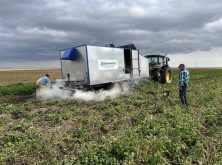Q: What can I do to reduce potential herbicide-resistance issues?
A: Driver weed populations on a farm level tend to remain relatively consistent over time. Some species may move into cropland from field edges and pasture lands and others may leave with reduction in tillage. Generally, the weed species that cause most issues on a yearly basis tend to stay the same.
Stable weed populations can allow for predictive planning and proactive management, but if things are not done properly, problems can arise. Weeds can develop resistance to herbicide applications rather quickly, making it important to utilize multiple control measures to prolong herbicide efficacy.
Read Also

Claas brings 1000 Series SP forage harvesters to Canada
In mid-August, Claas unveiled its new line of Jaguar forage harvesters at an event in Visalia, California, deep in the heart of that state’s dairy region.
There are many ways to manage weed populations on the farm but, generally, most approaches will start with three foundational elements — proper identification, utilizing multiple control strategies and post-season evaluation.
Proper weed identification is vital for implementing a multi-faceted approach to control.
All plant species have different attributes that can allow for more successful non-herbicide control. Timing of seed drop, root morphology and growing point location can all be targets of a cultural control measure.
Cultural control methods should be incorporated as well. Silaging and sometimes even tillage can be effective tools in reducing weed issues. Certain species can be removed from the field before reaching maturity and others can be controlled by physical damage.
Rotating herbicide groups and, when possible, applying multiple groups with effective weed control will also help our battle with weed resistance.
By rotating herbicides, we are reducing selection pressure in our fields — without rotating herbicide groups, we quickly allow weed populations that are not controlled to dominate the weed seed bank. By utilizing both chemical and cultural control strategies, we can create a solid foundation for our weed management plan.
Finally, critical evaluation of weed control measures allows for proper long-term management planning to take place. Scouting fields to determine herbicide efficacy and following up where needed with weed seed collection and resistance testing can create an invaluable dataset. Growers can utilize this data to create a plan that will successfully leverage crop rotation in addition to cultural and chemical weed control applications to maintain lower levels of herbicide resistance.
– Jordan Peterson, PAg, CCA, is a manager of agronomic solutions with Nutrien Ag Solutions in northern Alberta.















